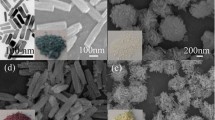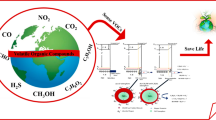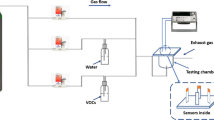Abstract
Methanol is one of the characteristic gases that distinguish between healthy individuals and lung cancer (LC) lesions in exhaled human breath. Its concentration in exhaled breath is generally below one part per million (1×10−6). The second-phase composite is widely regarded as one of the methods to improve the gas-sensing performance of metal oxide semiconductor (MOS) materials. In this study, LaF3–Co3O4 was synthesized by a simple hydrothermal method to enhance its low-concentration methanol gas-sensing performance. 5 at% LaF3–Co3O4 nanorods exhibited excellent methanol detection performance, including a wider linear detection concentration range (0.2×10−6–5×10−6), a response value exceeding 4.0 for 1×10−6 methanol at 275 °C and 75% relative humidity (RH), long-term stability (maximum deviation within 15% over 2 weeks), and excellent selectivity. The mechanism of performance enhancement was studied using various techniques, and density functional theory. The special spinel structure of Co3O4, the high ionic migration of F− in LaF3, the larger specific surface area of 5 at% LaF3–Co3O4 nanorods, and the generated crystal defects all explain the excellent methanol gas-sensing property. This work provides a novel route to prepare MOS composite materials for low-concentration methanol gas detection.
Graphical abstract

摘要
甲醇是人体呼出气中区分健康个体和肺癌患者的特征气体之一。其在呼出气体中的浓度通常低于ppm。第二相复合材料被广泛认为是提高金属氧化物半导体(MOS)材料气敏性能的方法之一。本研究采用简单水热法合成了LaF3–Co3O4, 以提高其低浓度甲醇气敏性能。5 at% LaF3–Co3O4纳米棒表现出优异的甲醇检测性能, 包括较宽的线性检测浓度范围(0.2–5 ppm), 在275℃和75%相对湿度下, 对1 ppm甲醇的响应值超过4.0, 长期稳定性(2周内最大偏差在15%以内), 以及出色的选择性。利用各种技术和密度泛函理论研究了性能增强的机理。Co3O4特殊的尖晶石结构、LaF3中F−的高离子迁移、5 at% LaF3–Co3O4纳米棒的大比表面积以及产生的晶体缺陷都解释了其优异的甲醇气敏性能。本工作为制备用于低浓度甲醇气体检测的MOS复合材料提供了一条新方法。






Similar content being viewed by others
References
Sung H, Ferlay J, Siegel RL, Laversanne M, Soerjomataram I, Jemal A, Bray F. Global cancer statistics 2020: globocan estimates of incidence and mortality worldwide for 36 cancers in 185 countries. CA Cancer J Clin. 2021;71(3):209. https://doi.org/10.3322/caac.21660.
Nasim F, Sabath BF, Eapen GA. Lung cancer. Med Clin North Am. 2019;103(3):463. https://doi.org/10.1016/j.mcna.2018.12.006.
Bajtarevic A, Ager C, Pienz M, Klieber M, Schwarz K, Ligor M, Ligor T, Filipiak W, Denz H, Fiegl M, Hilbe W, Weiss W, Lukas P, Jamnig H, Hackl M, Haidenberger A, Buszewski B, Miekisch W, Schubert J, Amann A. Noninvasive detection of lung cancer by analysis of exhaled breath. BMC Cancer. 2009;9:348. https://doi.org/10.1186/1471-2407-9-348.
Li YX, Deng DY, Xing XX, Chen N, Liu X, Xiao XC, Wang YD. A high performance methanol gas sensor based on palladium-platinum-In2O3 composited nanocrystalline SnO2. Sens Actuators B Chem. 2016;237(28):133. https://doi.org/10.1016/j.snb.2016.06.088.
Rong Q, Xiao B, Zeng J, Yu R, Zi B, Zhang G, Zhu ZQ, Zhang J, Wu JS, Qingju Liu QJ. Pt Single atom-induced activation energy and adsorption enhancement for an ultrasensitive ppb-Level methanol gas sensor. ACS Sens. 2022;7(1):199. https://doi.org/10.1021/acssensors.1c01959.
Li K, Wu Y, Chen M, Rong Q, Zhu Z, Liu Q, Zhang J. High methanol gas-Sensing performance of Sm2O3/ZnO/SmFeO3 microspheres synthesized via a hydrothermal method. Nanoscale Res Lett. 2019;14:57. https://doi.org/10.1186/s11671-019-2890-5.
Chinh ND, Hung NM, Majumder S, Kim C, Kim D. Hole-supply-rate–Controlled methanol-gas-sensing reaction over p-type Co3O4/single-walled carbon nanotube hybrid structures. Sens Actuators B Chem. 2021;326:128956. https://doi.org/10.1016/j.snb.2020.128956.
Chen XW, Wang S, Su C, Han Y, Zou C, Zeng M, Hu NT, Su YJ, Zhou ZH, Yang Z. Two-dimensional Cd-doped porous Co3O4 nanosheets for enhanced room-temperature NO2 sensing performance. Sens Actuators B Chem. 2020;305: 127393. https://doi.org/10.1016/j.snb.2019.127393.
Kim HJ, Lee JH. Highly sensitive and selective gas sensors using p-type oxide semiconductors: overview. Sens Actuators B Chem. 2014;192:607. https://doi.org/10.1016/j.snb.2013.11.005.
Zhang C, Li Y, Liu GF, Liao HL. Preparation of ZnO1-x by peroxide thermal decomposition and its room temperature gas sensing properties. Rare Met. 2021;41(3):871. https://doi.org/10.1007/s12598-021-01840-y.
Yang Z, Cao W, Peng C, Wang T, Li B, Ma HL, Su YJ, Zhou ZH, Yang JH, Zeng M. Construction, application and verification of a novel formaldehyde gas sensor system based on Ni-doped SnO2 nanoparticles. IEEE Sensors J. 2021;21:11023. https://doi.org/10.1109/JSEN.2021.3053407.
Tan W, Tan J, Li L, Dun M, Huang X. Nanosheets-assembled hollowed-out hierarchical Co3O4 microrods for fast response/recovery gas sensor. Sens Actuators B Chem. 2017;249:66. https://doi.org/10.1016/j.snb.2017.04.068.
Deng S, Liu X, Chen N, Deng D, Xiao X, Wang Y. A highly sensitive VOC gas sensor using p-type mesoporous Co3O4 nanosheets prepared by a facile chemical coprecipitation method. Sens Actuators B Chem. 2016;233:615. https://doi.org/10.1016/j.snb.2016.04.138.
Hu J, Guan WW, Xiong XQ, Chen Y, Long H. Modulation of rGO–Co3O4 heterojunction with multi-walled carbon nanotubes for efficient ethanol detection. Sens Actuators B Chem. 2022;368:132202. https://doi.org/10.1016/j.snb.2022.132202.
Cai Z, Park S. Highly selective acetone sensor based on Co3O4-decorated porous TiO2 nanofibers. J Alloys Compd. 2022;919: 165875. https://doi.org/10.1016/j.jallcom.2022.165875.
Shi J, Xiong J, Qiao L, Liu C, Zeng Y. Facile MOF-on-MOF isomeric strategy for ZnO@Co3O4 single-shelled hollow cubes with high toluene detection capability. Appl Surf Sci. 2023;609: 155271. https://doi.org/10.1016/j.apsusc.2022.155271.
Li B, Jiang XF, Wu YP, Wan HQ, Chen L, Ye Y, Zhou HD, Chen JM. Novel environmental-friendly lubricating materials: water-based PAI-graphite-LaF3 bonded solid lubricating coatings. Appl Surf Sci. 2019;481:900. https://doi.org/10.1016/j.apsusc.2019.03.192.
Xu L, Song H, Hu J, Lv Y, Xu K. A cataluminescence gas sensor for triethylamine based on nanosized LaF3–CeO2. Sens Actuators B Chem. 2012;169:261. https://doi.org/10.1016/j.snb.2012.04.079.
Moritz W, Szeponik J, Lisdat F, Friebe A, Krause S, Hintsche R, Scheller F. Diversiform applications of LaF3 for chemical semiconductor sensors. Sens Actuators B Chem. 1992;7:497. https://doi.org/10.1016/0925-4005(92)80351-W.
Choi S-K, Yi CW, Cho WI, Cho BW, Ju JB, Yun KS, Yamazoe N. A MOSFET type sensor for oxygen sensing using LaF3 as a gate material. Sens Actuators B Chem. 1993;13:45. https://doi.org/10.1016/0925-4005(93)85319-6.
Tang MC, Wang ZJ, Wang DY, Mao RY, Zhang H, Xu W, Yang Z, Zhang DZ. Construction of LaF3 QD-modified SnS2 nanorod composites for ultrasensitive detection of H2S. J Mater Chem A. 2023;11:9942. https://doi.org/10.1039/D2TA08496A.
Zhang YJ, Wu YW, Duan ZH, Liu BH, Zhao QN, Yuan Z, Li SR, Liang JG, Jiang YD, Tai HL. High performance humidity sensor based on 3D mesoporous Co3O4 hollow polyhedron for multifunctional applications. Appl Surf Sci. 2022;585:152698. https://doi.org/10.1016/j.apsusc.2022.152698.
Wang ZY, Jiang SD, Duan CQ, Wang D, Luo SH, Liu YG. In situ synthesis of Co3O4 nanoparticles confined in 3D nitrogen-doped porous carbon as an efficient bifunctional oxygen electrocatalyst. Rare Met. 2020;39(12):1383. https://doi.org/10.1007/s12598-020-01581-4.
Yoon A, Kim G, Lee M, Lee Z, Ryu GH. Thermally driven phase transition of cobalt hydroxide sheets via cobalt oxides to cobalt nanoparticles. Nanoscale Horiz. 2022;7:1210. https://doi.org/10.1039/d2nh00218c.
Zhou TT, Zhang T, Deng JN, Zhang R, Lou Z, Wang LL. P-type Co3O4 nanomaterials-based gas sensor: preparation and acetone sensing performance. Sens Actuators B Chem. 2017;242(3):369. https://doi.org/10.1016/j.snb.2016.11.067.
Kong DH, Zhou WR, Han JY, Gao YB, Gao Y, Zhao LP, Sun P, Lu GY. Mesoporous Co3O4 nanosheets with exposed Co2+-rich crystal facets for improved toluene detection. Appl Surf Sci. 2023;619:156714. https://doi.org/10.1016/j.apsusc.2023.156714.
Wang D, Zhao HM, Guo L, Zhang L, Zhao HB, Fang X, Li S, Wang G. Facile synthesis of CuO–Co3O4 prickly-sphere-like composite for non-enzymatic glucose sensors. Rare Met. 2022;41(6):1911. https://doi.org/10.1007/s12598-021-01939-2.
Li JY, Wang XY, Tian J, Zhang XL, Shi F. Co-Fe quantum dots coupled with ultrathin g-C3N4 nanosheets as efficient and stable photo-Fenton catalysts. Rare Met. 2023;42(6):1877. https://doi.org/10.1007/s12598-022-02226-4.
Tran NT, Le QV, Cuong NV, Nguyen TD, Huy Phuc NH, Phuong PTT, Monir MU, Aziz AA, Truong QD, Abidin SZ, Nanda S, Vo DVN. La-doped cobalt supported on mesoporous alumina catalysts for improved methane dry reforming and coke mitigation. J Energy Inst. 2020;93:1571. https://doi.org/10.1016/j.joei.2020.01.019.
Zhao X, Yin F, He X, Chen B, Li G. Enhancing hydrogen evolution reaction activity on cobalt oxide in alkaline electrolyte by doping inactive rare-earth metal. Electrochim Acta. 2020;363: 137230. https://doi.org/10.1016/j.electacta.2020.137230.
Secu CE, Matei E, Negrila C, Secu M. The influence of the nanocrystals size and surface on the Yb/Er doped LaF3 luminescence properties. J Alloys Compd. 2019;791:1098. https://doi.org/10.1016/j.jallcom.2019.03.267.
Tamilmani V, Soni AK, Rai VK, Nair BU, Sreeram KJ. Frequency upconversion in catechin assisted: square nanoplates. J Chem Sci. 2017;129:1929. https://doi.org/10.1007/s12039-017-1401-4.
Chen JT, Wang J, Zhang F, Zhang GA, Wu ZG, Yan PX. The effect of La doping concentration on the properties of zinc oxide films prepared by the sol-gel method. J Cryst Growth. 2008;310:2627. https://doi.org/10.1016/j.jcrysgro.2008.01.011.
Xu J, Zhang C. Oxygen vacancy engineering on cerium oxide nanowires for room-temperature linalool detection in rice aging. J Adv Ceram. 2022;11:1559. https://doi.org/10.1007/s40145-022-0629-8.
Zhang C, Huan Y, Li Y, Luo Y, Debliquy M. Low concentration isopropanol gas sensing properties of Ag nanoparticles decorated In2O3 hollow spheres. J Adv Ceram. 2022;11:379. https://doi.org/10.1007/s40145-021-0530-x.
Wu KD, Xu JY, Debliquy M, Zhang C. Synthesis and NH3/TMA sensing properties of CuFe2O4 hollow microspheres at low working temperature. Rare Met. 2021;40(7):1768. https://doi.org/10.1007/s12598-020-01609-9.
Zhang H, Xiao J, Chen J, Zhang L, Zhang Y, Pei XL. Pd-modified SmFeO3 with hollow tubular structure under light shows extremely high acetone gas sensitivity. Rare Met. 2023;42(2):545. https://doi.org/10.1007/s12598-022-02192-x.
Han B, Wang H, Yang W, Wang J, Wei X. Hierarchical Pt-decorated In2O3 microspheres with highly enhanced isoprene sensing properties. Ceram Int. 2021;47:9477. https://doi.org/10.1016/j.ceramint.2020.12.081.
Liu J, Zhang L, Cheng B, Fan J, Yu J. A high-response formaldehyde sensor based on fibrous Ag–ZnO/In2O3 with multi-level heterojunctions. J Hazard Mater. 2021;413:125352. https://doi.org/10.1016/j.jhazmat.2021.125352.
Jiang C, Guo X, Jia L, Zhao Z, Yang R, Chen X, Deng Q. LaF3 doped Co3O4 mesoporous nanomaterials with hierarchical structure for enhanced triethylamine gas sensing performances. J Electrochem Soc. 2021;168:97509. https://doi.org/10.1149/1945-7111/ac268a.
Chai HF, Li Y, Luo YF, Debliquy M, Zhang C. Investigation on isopropanol sensing properties of LnFeO3 (Ln = Nd, Dy, Er) perovskite materials synthesized by microwave-assisted hydrothermal method. Appl Surf Sci. 2022;601:154292. https://doi.org/10.1016/j.apsusc.2022.154292.
Wang TS, Zhang SF, Yu Q, Wang SP, Sun P, Lu HY, Liu FM, Yan X, Lu GY. Novel self-assembly route assisted ultra-fast trace volatile organic compounds gas sensing based on three-dimensional opal microspheres composites for diabetes diagnosis. ACS Appl Mater Interfaces. 2018;10:32913. https://doi.org/10.1021/acsami.8b13010.
Li Y, Lu YL, Wu KD, Zhang DZ, Debliquy M, Zhang C. Microwave-assisted hydrothermal synthesis of copper oxide-based gas-sensitive nanostructures. Rare Met. 2021;40(6):1477. https://doi.org/10.1007/s12598-020-01557-4.
Fan C, Shi J, Zhang YW, Quan WJ, Chen XY, Yang JH, Zeng M, Zhou ZH, Su YJ, Wei H, Yang Z. Fast and recoverable NO2 detection achieved by assembling ZnO on Ti3C2Tx MXene nanosheets under UV illumination at room temperature. Nanoscale. 2022;14:3441. https://doi.org/10.1039/d1nr06838e.
Qin J, Cui Z, Yang X, Zhu S, Li Z, Liang Y. Three-dimensionally ordered macroporous La1-xMgxFeO3 as high performance gas sensor to methanol. J Alloys Compd. 2015;635:194. https://doi.org/10.1016/j.jallcom.2015.01.226.
Zeng Y, Hua ZQ, Tian XM, Li X, Qiu ZL, Zhang CS, Wang MJ, Li EP. Selective detection of methanol by zeolite/Pd-WO3 gas sensors. Sens Actuators B Chem. 2018;273:1291. https://doi.org/10.1016/j.snb.2018.07.041.
Zheng Z, Liu K, Zhou Y, Debliquy M, Zhang C. Ultrasensitive room-temperature geranyl acetone detection based on Fe@WO3-x nanoparticles in cooked rice flavor analysis. J Adv Ceram. 2023;12(8):1547. https://doi.org/10.26599/JAC.2023.9220771.
He XX, Chai HF, Luo YF, Min LF, Debliquy M, Zhang C. Metal oxide semiconductor gas sensing materials for early lung cancer diagnosis. J Adv Ceram. 2023;12:207. https://doi.org/10.26599/jac.2023.9220694.
Xing XJ, Jian X, Zhang LB, Lu HP, Zhang ZW, Agathopoulos S, Yin LJ, Deng LJ. Strategy to boost hydrolysis resistance and stabilize low infrared emissivity of ZrB2 via nanoscale LaF3 surface modification. Rare Met. 2022;41(12):4164. https://doi.org/10.1007/s12598-022-02108-9.
He CZ, Zhang YX, Wang J, Fu L. Anchor single atom in h-BN assist NO synthesis NH3: a computational view. Rare Met. 2022;41(10):3456. https://doi.org/10.1007/s12598-022-02059-1.
Xiong K, Wang BW, Sun ZP, Li W, Jin CC, Zhang SM, Xu SY, Guo L, Mao Y. Frist-principles prediction of elastic, electronic, and thermodynamic properties of high entropy carbide ceramic (TiZrNbTa)C. Rare Met. 2022;41(3):1002. https://doi.org/10.1007/s12598-021-01834-w.
Zhang SM, Xiong K, Jin CC, Li ZB, He JJ, Mao Y. Stacking fault, dislocation dissociation, and twinning in Pt3Hf compounds: a DFT study. Rare Met. 2021;40(4):1020. https://doi.org/10.1007/s12598-020-01651-7.
Acknowledgements
This work was financially supported by the Outstanding Youth Foundation of Jiangsu Province of China (No. BK20211548) and Yangzhou City-Yangzhou University Cooperation Foundation (No. YZ2021153).
Author information
Authors and Affiliations
Corresponding author
Ethics declarations
Conflict of interests
The authors declare that they have no conflict of interest.
Supplementary Information
Below is the link to the electronic supplementary material.
Rights and permissions
Springer Nature or its licensor (e.g. a society or other partner) holds exclusive rights to this article under a publishing agreement with the author(s) or other rightsholder(s); author self-archiving of the accepted manuscript version of this article is solely governed by the terms of such publishing agreement and applicable law.
About this article
Cite this article
He, XX., Chai, HF., Zhou, YW. et al. Sensing properties and mechanisms of LaF3–Co3O4 nanorods for low-concentration methanol detection. Rare Met. 43, 2193–2204 (2024). https://doi.org/10.1007/s12598-023-02593-6
Received:
Revised:
Accepted:
Published:
Issue Date:
DOI: https://doi.org/10.1007/s12598-023-02593-6




